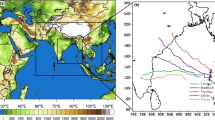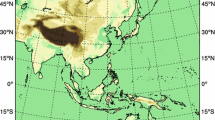Abstract
In this paper, the performance of a high-resolution mesoscale model for the prediction of severe tropical cyclones over the Bay of Bengal during 2007–2010 (Sidr, Nargis, Aila, and Laila) is discussed. The advanced Weather Research Forecast (WRF) modeling system (ARW core) is used with a combination of Yonsei University PBL schemes, Kain-Fritsch cumulus parameterization, and Ferrier cloud microphysics schemes for the simulations. The initial and boundary conditions for the simulations are derived from global operational analysis and forecast products of the National Center for Environmental Prediction-Global Forecast System (NCEP-GFS) available at 1°lon/lat resolution. The simulation results of the extreme weather parameters such as heavy rainfall, strong wind and track of those four severe cyclones, are critically evaluated and discussed by comparing with the Joint Typhoon Warning Center (JTWC) estimated values. The simulations of the cyclones reveal that the cyclone track, intensity, and time of landfall are reasonably well simulated by the model. The mean track error at the time of landfall of the cyclone is 98 km, in which the minimum error was found to be for the cyclone Nargis (22 km) and maximum error for the cyclone Laila (304 km). The landfall time of all the cyclones is also fairly simulated by the model. The distribution and intensity of rainfall are well simulated by the model as well and were comparable with the TRMM estimates.






Similar content being viewed by others
References
Asnani GC (2005) Tropical meteorology, vol 2. Praveen Printing Press, Pune, India, 9:1–140
Bengtsson L (2001) Hurricane threats. Science 293:440–441
Bhaskar Rao DV, Hariprasad D (2007) Sensitivity of tropical cyclone intensification to boundary layer and convective processes. Nat Hazards 41:429–445
Braun SA, Tao WK (2000) Sensitivity of high resolution simulations of hurricane Bob (1991) to the planetary boundary layer parameterization. Mon Weather Rev 128:3941–3961
Chang HI, Kumar A, Niyogi D, Mohanty UC, Chen F, Dudhia J (2009) The role of land surface processes on the mesoscale simulation of the July 26, 2005 heavy rain event over Mumbai, India. Global Planet Change 67:87–103
Cheng WYY, Steenburgh WJ (2005) Evaluation of surface sensible weather forecasts by WRF and ETA models over the western United States. Weather Forecast 20:812–821
Dudhia J (1989) Numerical study of convection observed during the winter monsoon experiment using a mesoscale two-dimensional model. J Atmos Sci 46:3077–3177
Dudhia J (2004) The weather research and forecasting model (version 2.0) 2nd international workshop on next generation NWP model. Yonsei University Seoul, Korea, pp 19–23
Emanuel KA (2005) Increasing destructiveness of tropical cyclones over the past 30 years. Nature 436:686–688
Fovell RG, Su H (2007) Impact of cloud microphysics on hurricane track forecasts. Geophys Res Lett 34:L24810. doi:10.1029/2007GL031723
Hong SY, Noh Y, Dudhia J (2006) A new vertical diffusion package with an explicit treatment of entrainment processes. Mon Weather Rev 134:2318–2341
Huffman GJ, Adler RF, Bolvin DT, Gu G, Nelkin EJ, Bowman KP, Hong Y, Stocker EF, Wolff DB (2007) The TRMM multi-satellite precipitation analysis: quasi-global, multi-year, combined-sensor precipitation estimates at fine scale. J Hydrometeor 8(1):38–55
Indian Meteorological Department (2008) Report on cyclonic disturbances over north Indian Ocean during 2008, RSMC report, New Delhi, pp 108
Kain JS, Fritsch JM (1993) Convective parameterization for mesoscale models: the Kain-Fritsch scheme, the representation of cumulus convection in numerical models. In: Emanuel KA, Raymond DJ (eds) American Meteorological Society, 246 pp
Mandal M, Mohanty UC, Raman S (2004) A study on the impact of parameterization of physical processes on prediction of tropical cyclone over the Bay of Bengal with NCAR/PSU mesoscale model. Nat Hazards 31:391–414
Michalakes J, Dudhia J, Gill DO, Henderson T, Klemp J, Skamarock W, Wand W (2005) The weather research and forecast model: software architecture and performance. 11th workshop on high performance computing in meteorology. World Scientific, pp 156–168
Neumann CJ (1993) Global guide to tropical cyclone forecasting. WMO/TC-No. 560, Report no. TCP-31, World Meteorological Organization, Geneva, Switzerland
Raju PVS, Potty J, Mohanty UC (2011) Sensitivity of physical parameterizations on prediction of tropical cyclone Nargis over the Bay of Bengal using WRF model. Meteorol Atmos Phys. doi:10.1007/s00703-011-0151-y
Skamarock WC, Klemp JB (2008) A time-split non-hydrostatic atmospheric model for weather research and forecasting applications. J Comput Phys 227:3465–3485
Skamarock WC, Klemp JB, Dudhia J, Gill DO, Barker DM, Wang W, Powers JG (2005) A description of the advanced research WRF version 2, NCAR technical note TN-468 + ST, 88 pp
Sousounis PJ, Hutchinson TA, Marshall SF (2004) A comparison of MM5, WRF, RUC, ETA performance for Great Plains heavy precipitation event during the spring of 2003. In: 20th conference on weather analysis and forecasting, vol J24.6. American Meteorological Society, Seattle
Sujatha P, Mohanty UC (2008) A comparative study on prediction of MM5 and WRF models in simulation of tropical cyclones over Indian seas. Curr Sci 95(7):923–936
Tenerelli JE, Chen SS (2001) High resolution simulation of hurricane Floyd (1999) using MM5 with vertex following mesh refinements. In: Preprint, 18th conference on weather analysis and forecasting/14th conference on numerical weather prediction 30 July–2 Aug Ft-Lauderdale, Florida, AMS, J54-J56
Acknowledgments
The authors sincerely acknowledge NCEP for providing the global analysis and forecast fields, NASA for precipitation data; the track and intensity were furnished by JTWC. We thank Dr. Dev Niyogi of Purdue State University, USA, for his useful suggestion and two anonymous reviewers for their valuable comments on the manuscript. We also thank Mr. A. R. Subbiah, Director, RIMES, for the institutional support.
Author information
Authors and Affiliations
Corresponding author
Rights and permissions
About this article
Cite this article
Raju, P.V.S., Potty, J. & Mohanty, U.C. Prediction of severe tropical cyclones over the Bay of Bengal during 2007–2010 using high-resolution mesoscale model. Nat Hazards 63, 1361–1374 (2012). https://doi.org/10.1007/s11069-011-9918-1
Received:
Accepted:
Published:
Issue Date:
DOI: https://doi.org/10.1007/s11069-011-9918-1




